Pav Bhaji
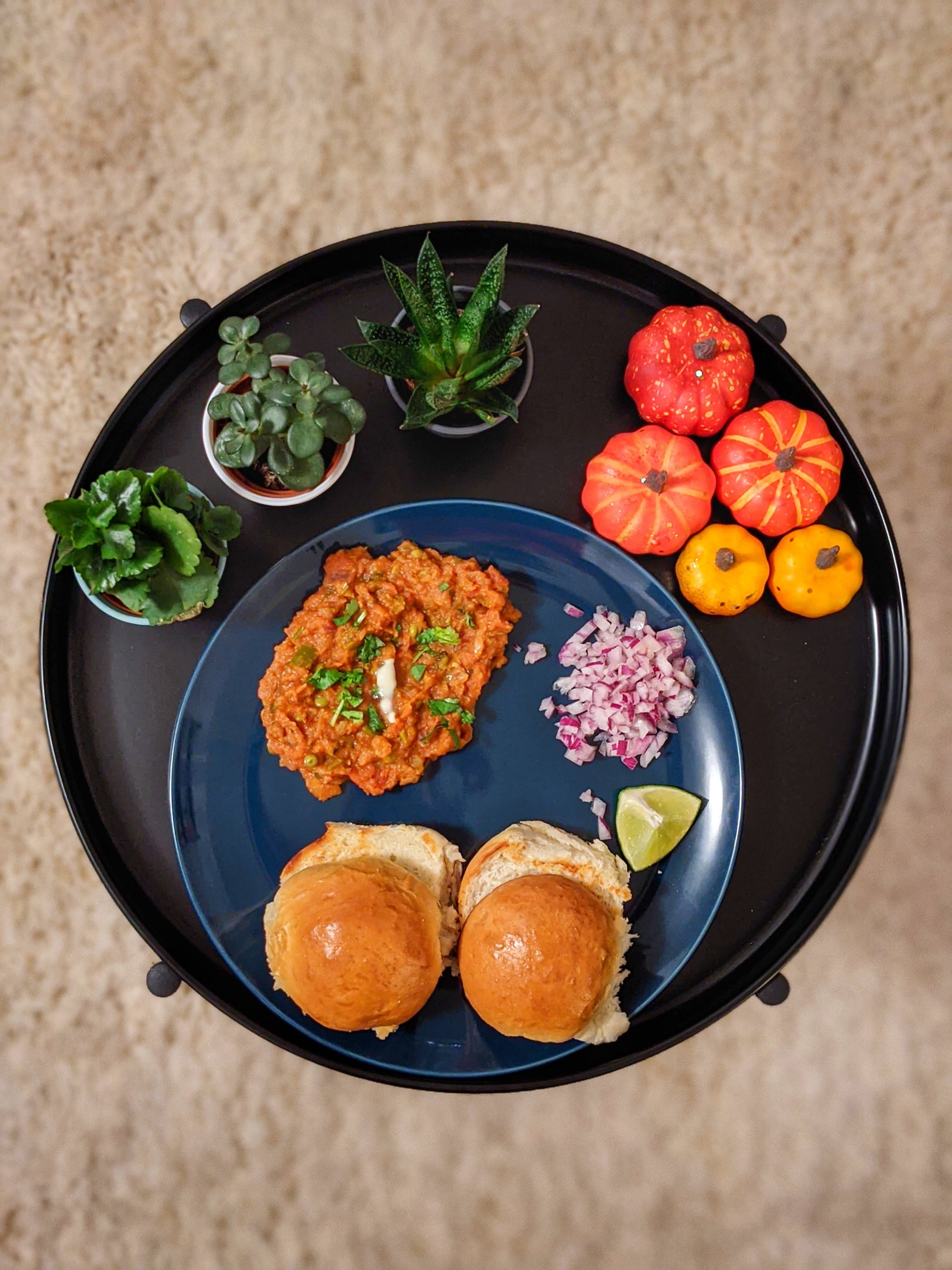
I’ve been missing my mother-in-law a lot lately. Maybe it’s the fact that I’ve been asked to avoid tea (something I drink five times a day,) and I associate that with the morning ritual I had with her, where I’d make my tea for her and we’d sit together to enjoy it. Or maybe it’s just the fact that each day is hard being away from home and all I want is to be in her calming presence and beautiful smile. She just has this innate ability to soothe you.
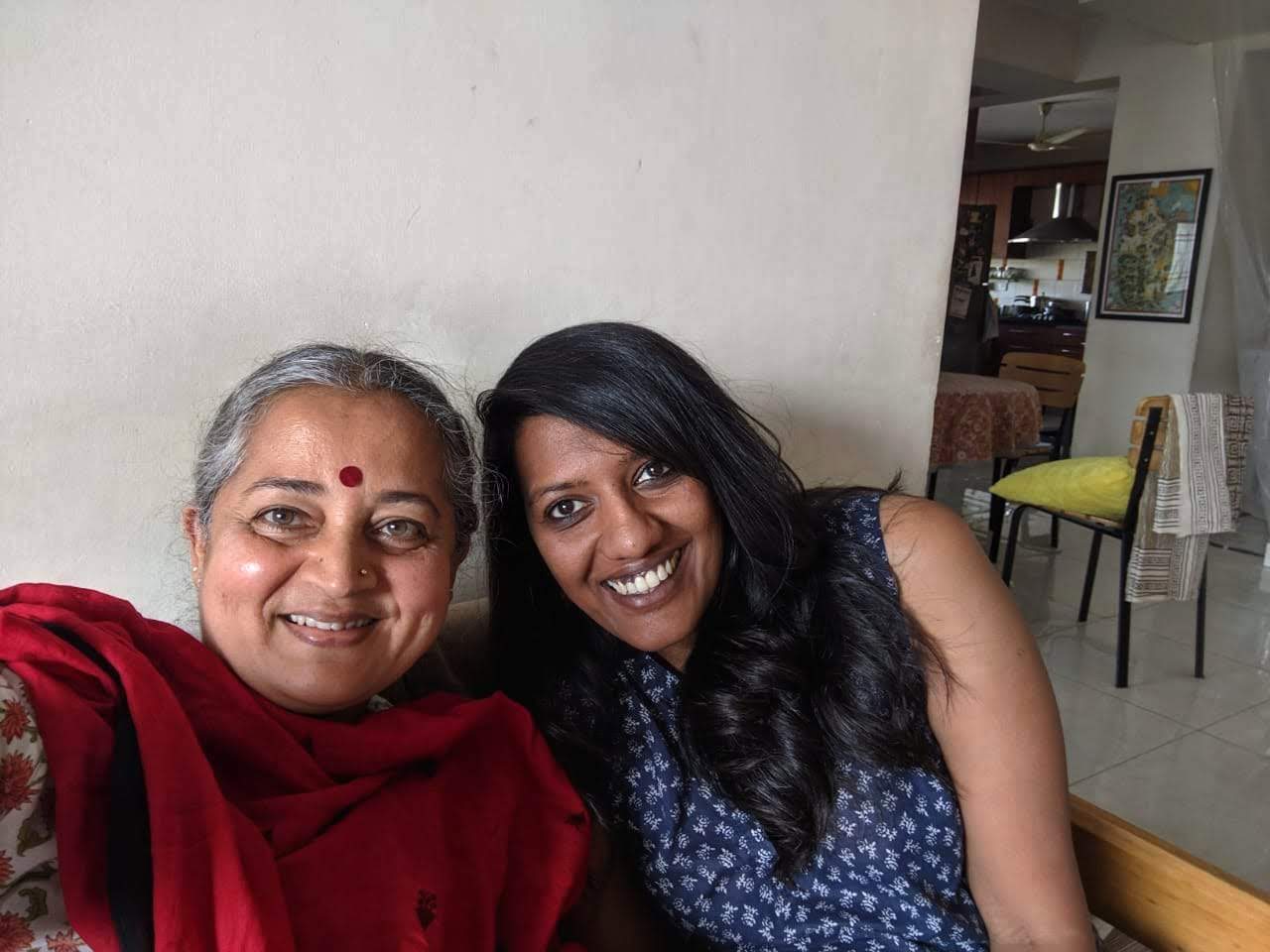
Before I met my mother-in-law, or “amma” as I call her now, I only knew of her as my best friend’s mom. She’s the revered Wormrani, saving the world from its own garbage. She gave TEDtalks and showed the chemical-free way of life to the world. She had videos of butterflies rising out of their cocoons to kiss her cheeks before they entered the world. She was Mother-friggin-Earth! It was intimidating and to me she was (and still is,) larger than life. The prospect of meeting her made me scared as hell.

In fact, the first time I went to their place, I was a nervous wreck and I wasn’t even there as Ni’s girlfriend, but just as one of the many Dartmouth friends who had been invited for dinner at his house. I remember the blood rushing to my face as I entered, my ears blowing out. Appa (my father-in-law) was sitting on the couch with his father-in-law, a frail, adorable man holding his oxygen tank. They were enjoying a Tamil serial and a drink together. I knew that Ni’s grandfather spoke Tamil, so I sat down to have a conversation with him, but I was so focused on that, that I misunderstood everything appa asked me.
Dear Lord, he must think I don’t understand English, I thought to myself.
But before I could drain into my circle of panic, amma came from the kitchen, said hello, and hugged me tight. And just like that, even though I was sweating from that tiny little interaction, I felt at home and the next thing I knew, I was asking her if she needed any help in the kitchen.
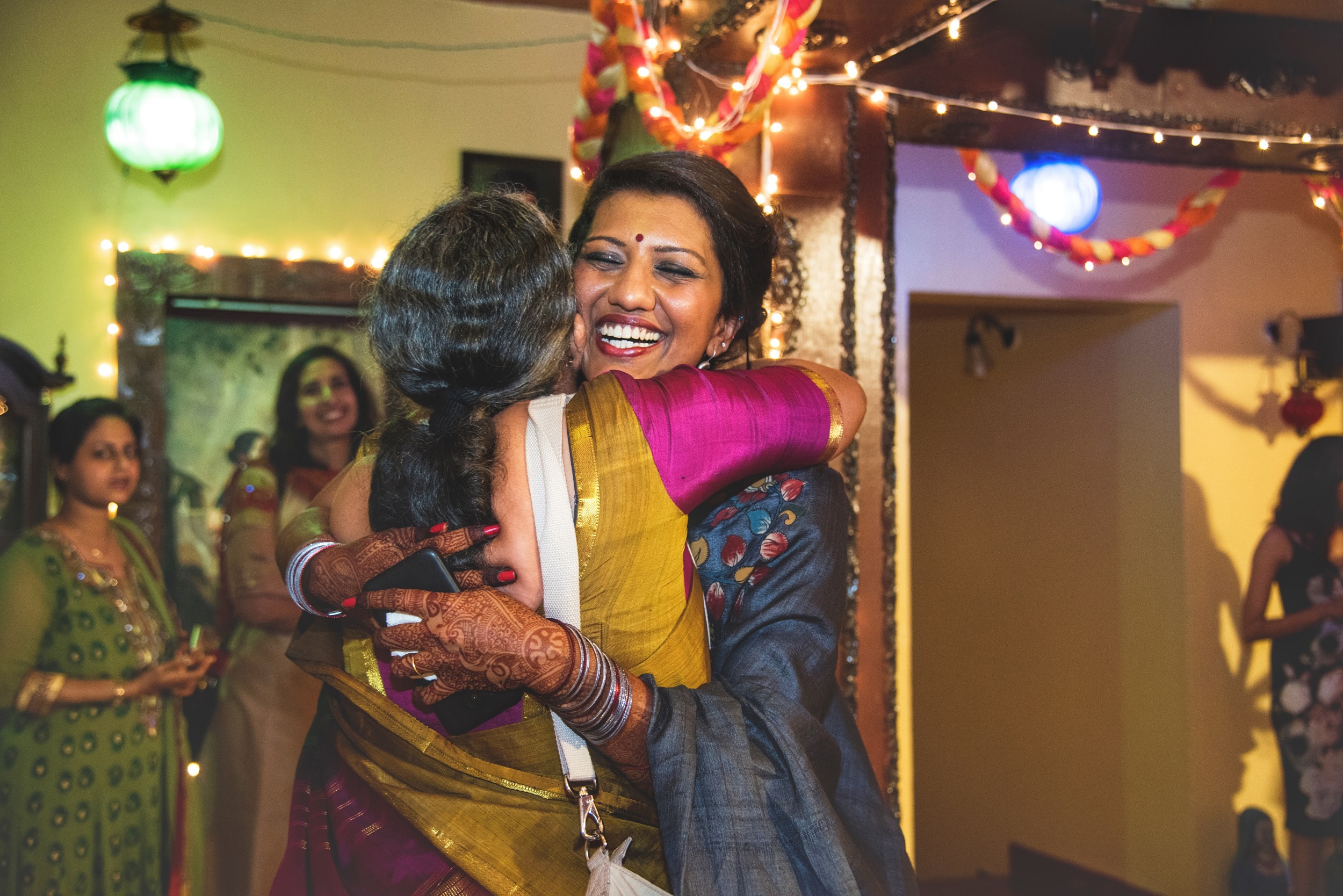
“I’ve got this. Why don’t you join your friends? Up the stairs,” she pointed.
It was only as I was climbing up, I realised that I was entering her world. Like I’d said, the first thing I knew about Ni’s mom, was that she was an urban farmer. Her whole terrace was just filled with plants. It was incredible. Ni took me around and introduced me to each of them and I couldn’t believe it. She was growing tomatoes, okra, beautiful white bulbs of brinjal, beans, peppers, chillies, spring onions, there were bitter gourds hanging off a vine, lime, ginger, curry leaves, and I’m pretty sure a tiny, adorable papaya tree. Not to mention an array of green leaves in her balcony downstairs. Her salad bar, as she likes to call it, has coriander, arugula, rockets, different kinds of spinach, methi, and even cabbage. I really couldn’t stop taking it all in. For a person who manages to kill cacti in a 40C environment, I can’t even imagine what it felt like to have so much life thriving at your fingertips. Being on her terrace, surrounded by all her dancing plants, especially in the rain, is an experience.
That night, she cooked up a feast for the whole lot of us, knowing exactly what we had all been missing. Chaat. Growing up, for most kids in India, eating chaat at a roadside push cart or the corner store was a ritual. There are many dishes that qualify as chaat, but I think the bottom line is that there is something crunchy, spicy, tangy, sweet, and sour. Each bite is an explosion of flavours in your mouth. Sometimes, it’s something as simple as roasted chopped potatoes (aloo chaat) tossed around in a combination of masalas that hit all the high notes. I still remember the first time I had it on a deadly cold night of about 9C in Sarojini market in Delhi. I was shivering, but as long as I had my aloo chaat I was okay. Sometimes, it’s all about the concoction of paani (cold lime water flavoured with a mint-coriander-chilli paste) and the adventure of putting the whole paani filled puri (an oval, hollow, crunchy ball about the size of a golf ball) into your mouth without spilling. A lot of chaat involves curd and a series of different coloured sauces and masala that goes on top.
That night, amma had made the whole variety with the crowning jewel of pav bhaji. Soft toasted buns served with a spicy, tangy, mixed vegetable curry, a side of chopped onions, minced cilantro, and a wedge of lime. Dear God, was that a welcome home after a year of being away.
I’ve been living away from home ever since I was 17 and never really thought I’d get homesick, but there I was, sitting in her terrace, the cool Bangalore wind hitting my face, being warmed up by hot, spicy pav bhaji, retrospectively missing home for the last one year.
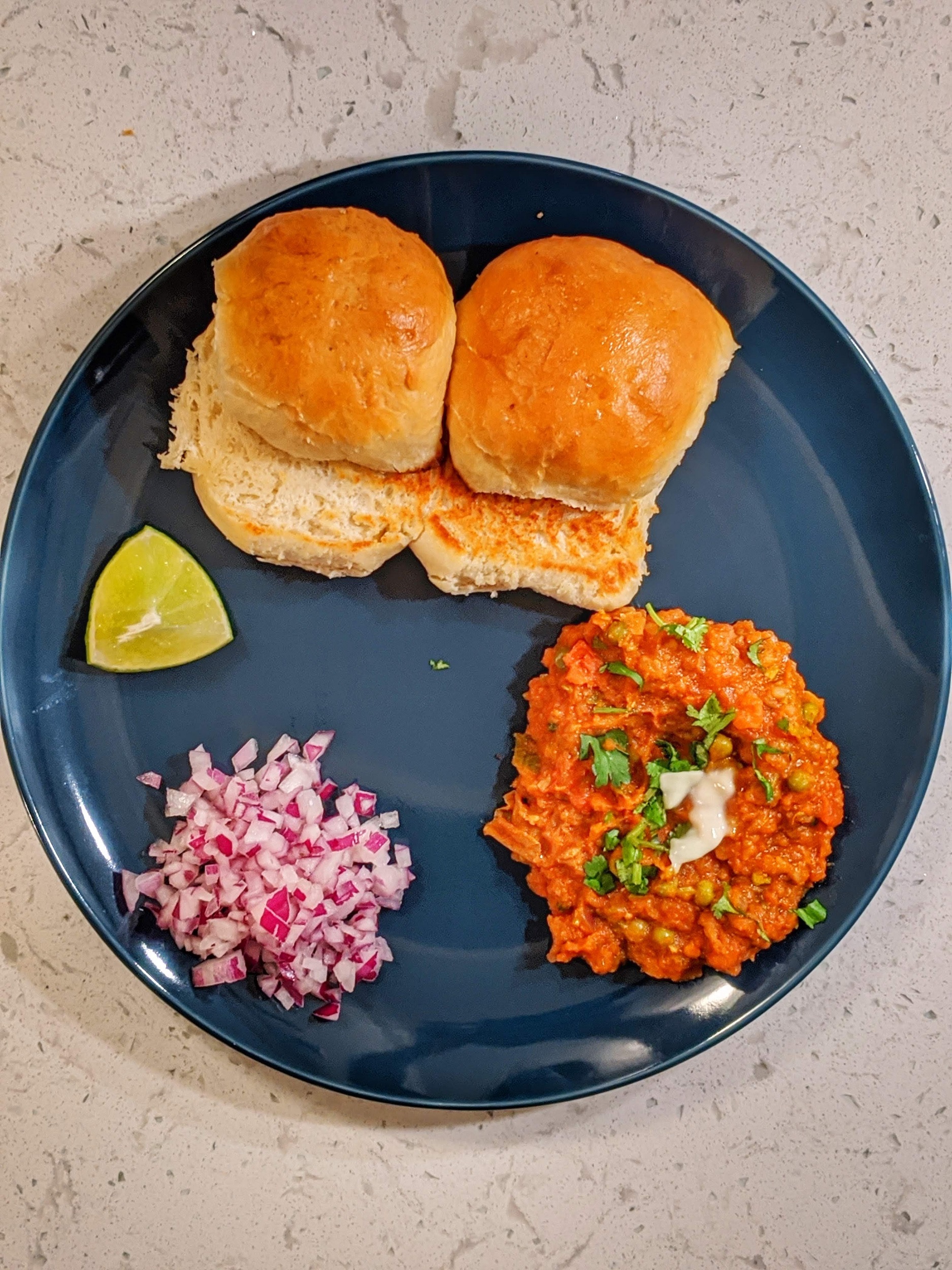
With all the struggles, the fear, the anxiety that this year has brought us, I keep wanting to go back to that garden, that moment, to that feeling, back to her, and the home she opened up to me.
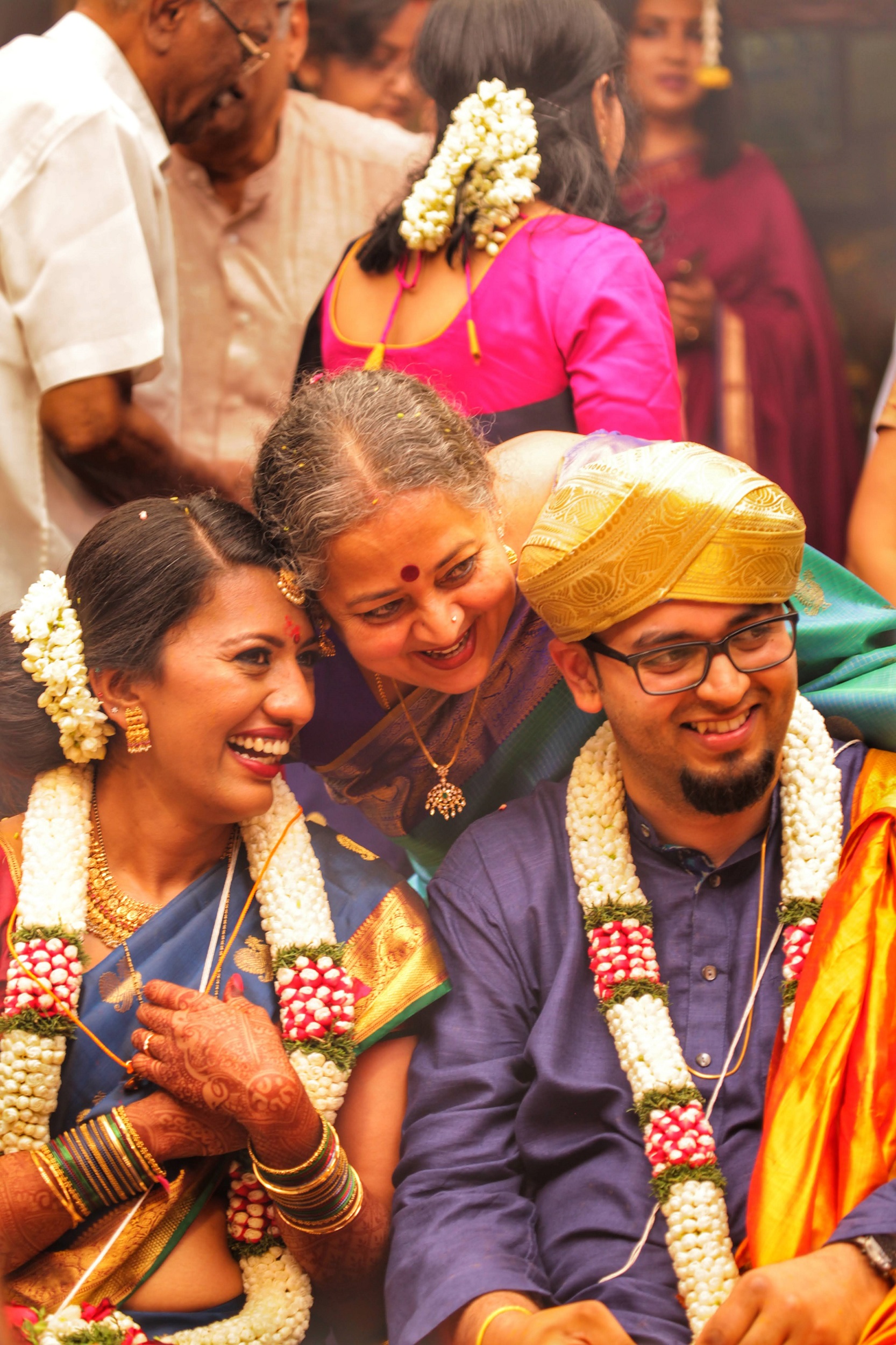
But since we are trapped in our homes and can’t cross borders, I did the next best thing that I knew would comfort me, make pav bhaji. Given the turn in weather, it seemed like the right time. Among chaat, pav bhaji is perhaps the easiest of them all because unlike the others, it essentially has only two components, the pav or the buns, and the bhaji, which is the mixed vegetable curry. You can find these buns easily in the supermarket (they are the light, fluffy dinner rolls you find in the bakery) or make them on your own. The process is quite simple, much like baking bread. If you are planning to make the pav (yaay,) start just an hour earlier giving time for the yeast to work its magic. In a large bowl, pour in some warm milk, a teaspoon of sugar and 2 teaspoons of yeast. Let this bloom for 5-10 minutes. Slowly add the flour and salt and knead it until it becomes soft. Add about a tablespoon of butter (room temp) and knead it some more. You can also use a stand mixer with the hook attachment. Once you are satisfied and the dough no longer breaks when you fold it, keep it in a lightly oiled bowl, cover and keep in a warm place for an hour. It should have doubled in size by them.

Meanwhile, we can start on the bhaji. In a big heated pan, add a dollop of butter and let it melt. Add chopped tomatoes, capsicum, peas, and mashed boiled potatoes, along with half a teaspoon of salt. Saute for a couple of minutes and add about half a cup of water. Cover and let this cook for 10-15 minutes. Once done, mash them all together and add kashmiri chilli powder and turmeric along with some crushed kasuri methi and chopped coriander. One of the other main ingredients is pav bhaji masala ( a powder made from blitzing dry roasted bay leaf, cinnamon, cloves, coriander seeds, cumin seeds, dried kashmiri chillies, pepper, and fennel,) but since I didn’t have any in my pantry, I substituted that with a combination of coriander, cumin, amla (sour gooseberries) powder. Now push all the masala to the sides and make a hole in the middle. Add a dollop of butter, chopped onions, minced coriander, ginger garlic paste, and chilli powder and cook it down a little. This is the method used by chaat shops all over, where the mashed masala is made in advance and with each order, they’d create a hole in the middle and freshly cook the onions. Add some water and cook it down until the consistency satisfies you.
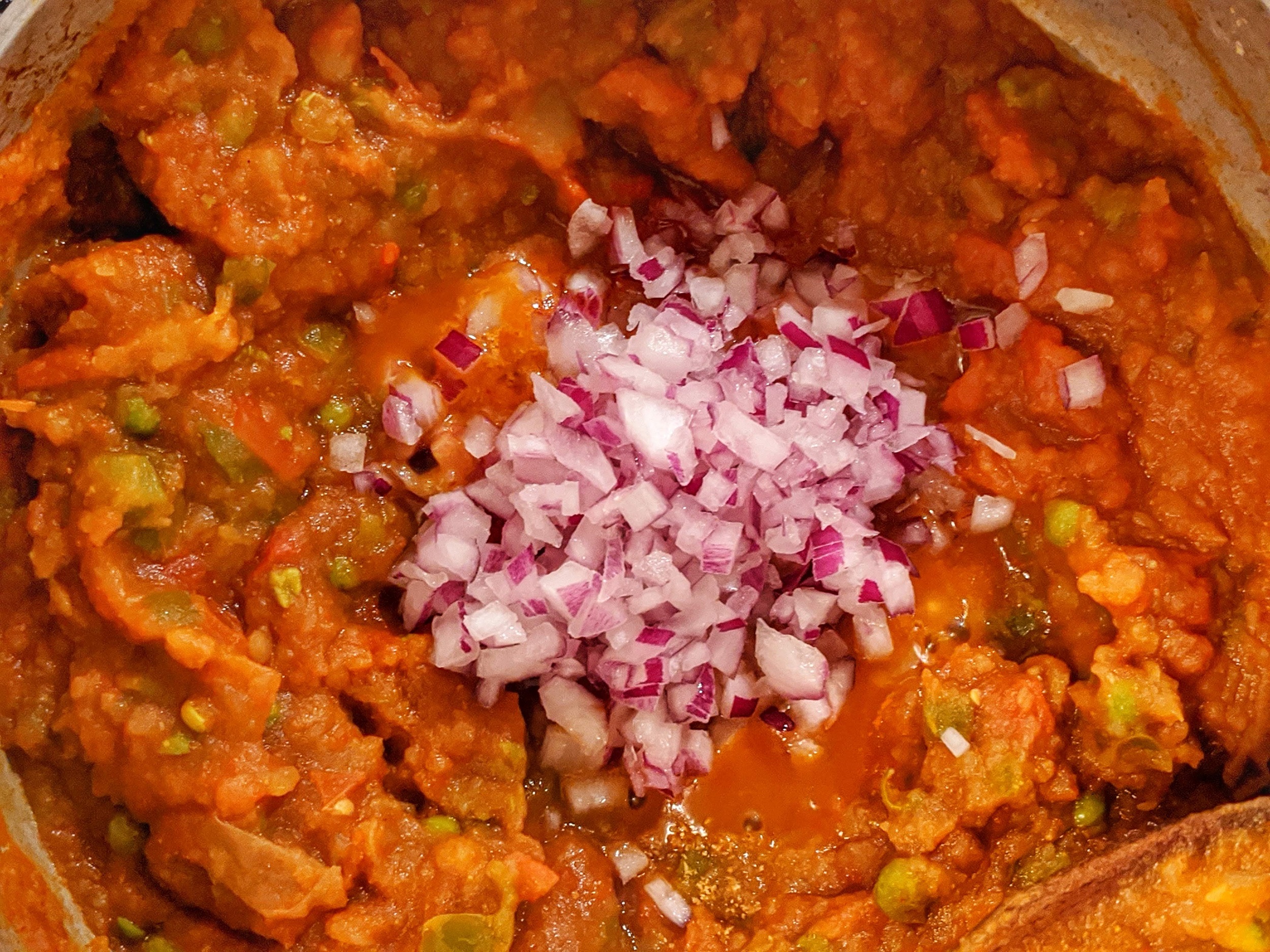
While the bhaji is cooking, we can go back to the pav. Lightly punch the dough to release the air and divide it into 8-12 equal parts. Gently roll them into a ball and place them on a baking tray, about an inch away from each other. Cover them and let them sit for another 20 minutes, they will increase in size, almost double again. Bake at 350 for about 20 mins, until the top becomes brown. Once out, brush the tops with butter to make them all soft and buttery.
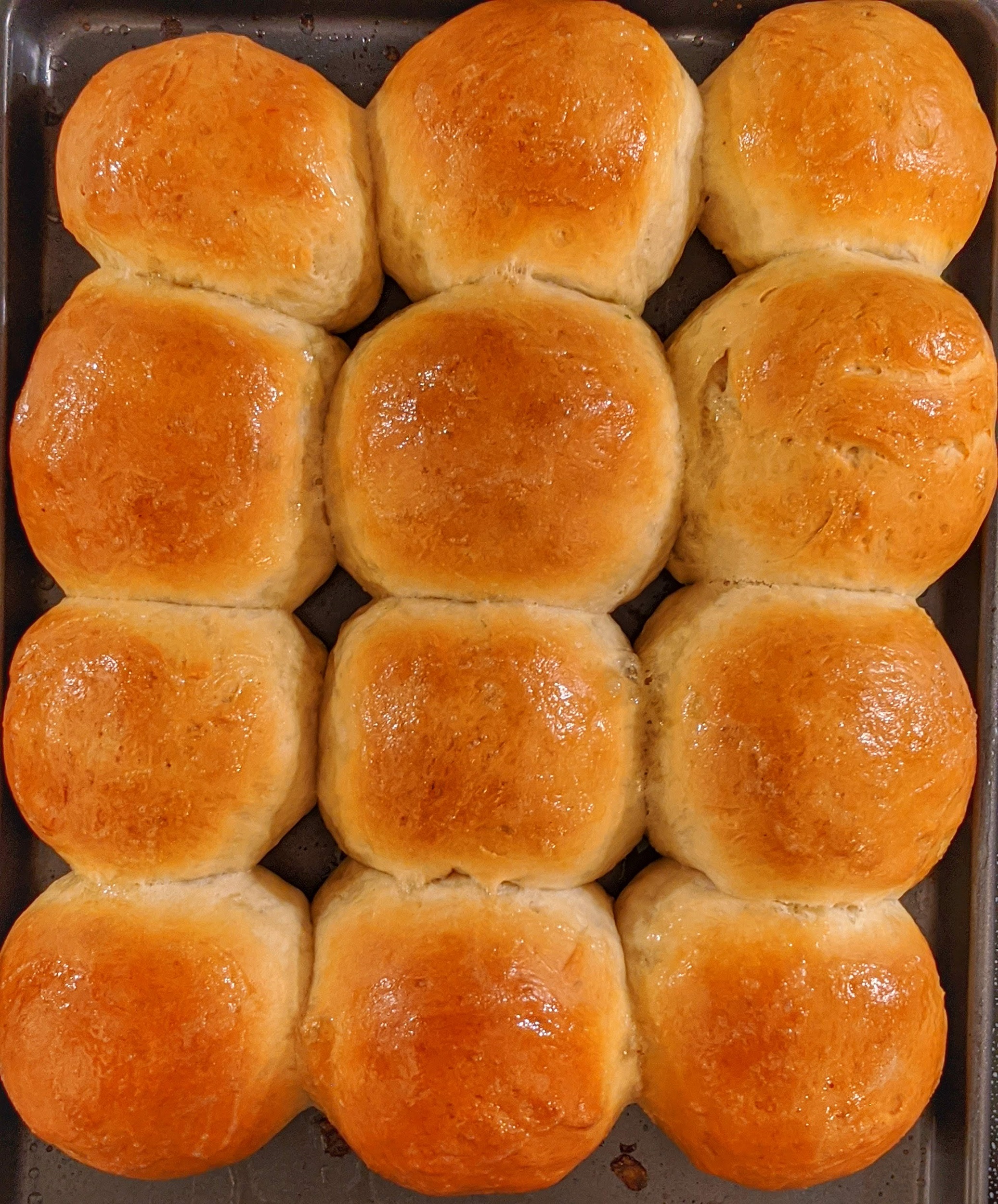
To serve the pav bhaji, slice the buns into half and roast them on a hot tawa (sliced part down.) On a plate, add the bhaji with a dollop of butter, some minced onions (on the side), and chopped coriander. Enjoy hot.
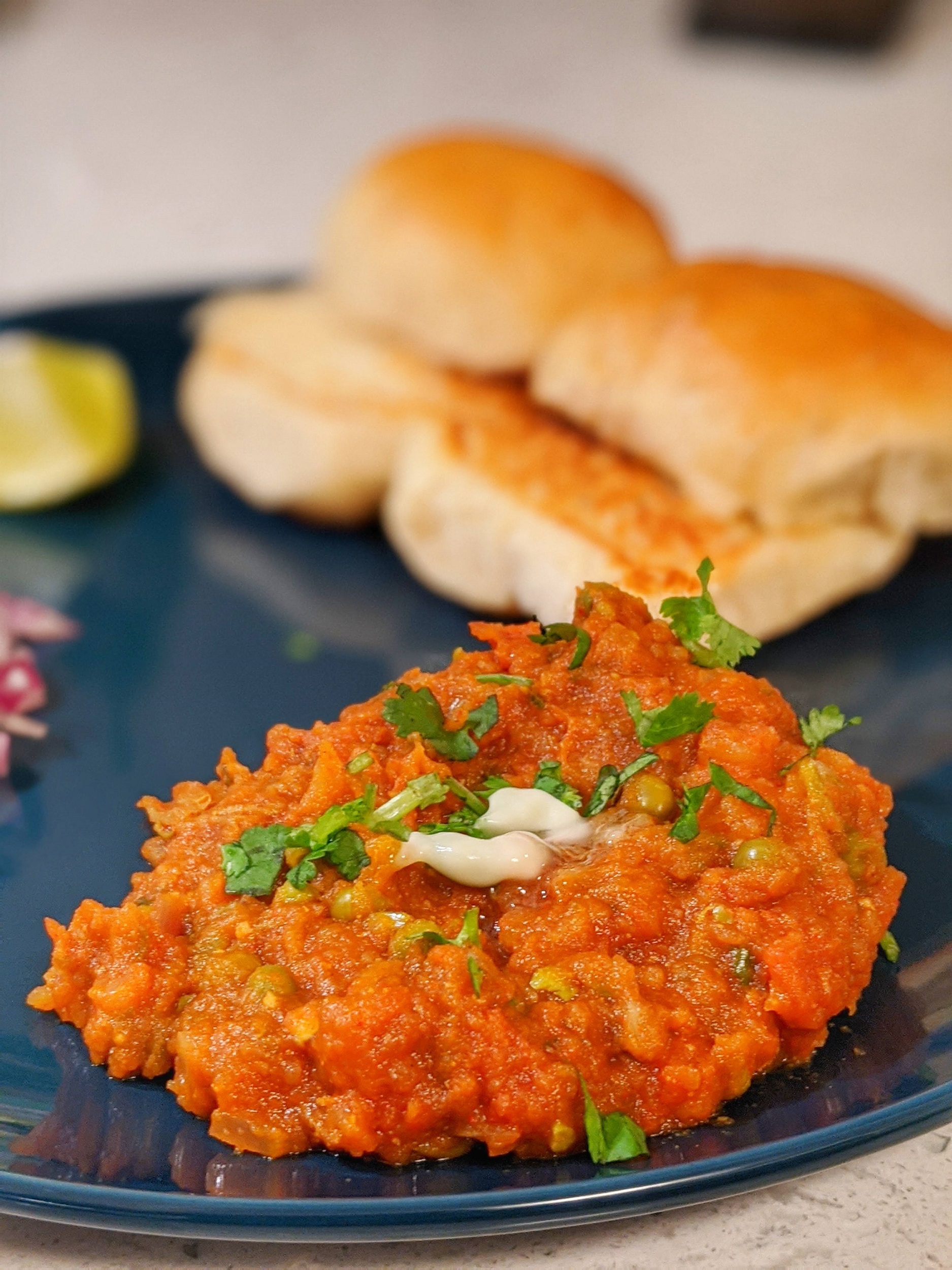
Soft toasted buns served with a spicy, tangy, mixed vegetable curry, a side of chopped onions, minced cilantro, and a wedge of lime. Recipe adapted from Hebbar's Kitchen.
In a large bowl, pour in some warm milk, a teaspoon of sugar and 2 teaspoons of yeast. Let this bloom for 5-10 minutes.
Slowly add the flour and salt and knead it until it becomes soft. Add about a tablespoon of butter (room temp) and knead it some more. You can also use a stand mixer with the hook attachment.
Once you are satisfied and the dough no longer breaks when you fold it, keep it in a lightly oiled bowl, cover and keep in a warm place for an hour. It should have doubled in size by them.
Lightly punch the dough to release the air and divide it into 8-12 equal parts.
Gently roll them into a ball and place them on a baking tray, about an inch away from each other. Cover them and let them sit for another 20 minutes, they will increase in size, almost double again.
Bake at 350 for about 20 mins, until the top becomes brown. Once out, brush the tops with butter to make them all soft and buttery.
In a big heated pan, add a dollop of butter and let it melt. Add chopped tomatoes, capsicum, peas, and mashed boiled potatoes, along with half a teaspoon of salt. Saute for a couple of minutes and add about half a cup of water. Cover and let this cook for 10-15 minutes.
Once done, mash them all together and add 1 tsp of kashmiri chilli powder, 1/4 tsp turmeric, 1/2 tsp of cumin, 1/2 tsp of coriander, and 1/2 tsp of amla powder, along with some crushed kasuri methi and chopped coriander. Mix well.
Now push all the masala to the sides and make a hole in the middle. Add a dollop of butter, chopped onions, minced coriander, a tsp of ginger garlic paste, and 1/2 tsp of kashmiri chilli powder and cook it down a little.
Add some water and cook it down until the consistency satisfies you. Garnish with freshly chopped cilantro.
Split the pav into half, apply butter generously and place it on a hot pan till it gets a light brown colour on each side.
Serve the roasted pav with a big spoonful of hot bhaji (with a dollop of butter), chopped onions, and a wedge of lime.
Ingredients
Directions
In a large bowl, pour in some warm milk, a teaspoon of sugar and 2 teaspoons of yeast. Let this bloom for 5-10 minutes.
Slowly add the flour and salt and knead it until it becomes soft. Add about a tablespoon of butter (room temp) and knead it some more. You can also use a stand mixer with the hook attachment.
Once you are satisfied and the dough no longer breaks when you fold it, keep it in a lightly oiled bowl, cover and keep in a warm place for an hour. It should have doubled in size by them.
Lightly punch the dough to release the air and divide it into 8-12 equal parts.
Gently roll them into a ball and place them on a baking tray, about an inch away from each other. Cover them and let them sit for another 20 minutes, they will increase in size, almost double again.
Bake at 350 for about 20 mins, until the top becomes brown. Once out, brush the tops with butter to make them all soft and buttery.
In a big heated pan, add a dollop of butter and let it melt. Add chopped tomatoes, capsicum, peas, and mashed boiled potatoes, along with half a teaspoon of salt. Saute for a couple of minutes and add about half a cup of water. Cover and let this cook for 10-15 minutes.
Once done, mash them all together and add 1 tsp of kashmiri chilli powder, 1/4 tsp turmeric, 1/2 tsp of cumin, 1/2 tsp of coriander, and 1/2 tsp of amla powder, along with some crushed kasuri methi and chopped coriander. Mix well.
Now push all the masala to the sides and make a hole in the middle. Add a dollop of butter, chopped onions, minced coriander, a tsp of ginger garlic paste, and 1/2 tsp of kashmiri chilli powder and cook it down a little.
Add some water and cook it down until the consistency satisfies you. Garnish with freshly chopped cilantro.
Split the pav into half, apply butter generously and place it on a hot pan till it gets a light brown colour on each side.
Serve the roasted pav with a big spoonful of hot bhaji (with a dollop of butter), chopped onions, and a wedge of lime.
Just wow!